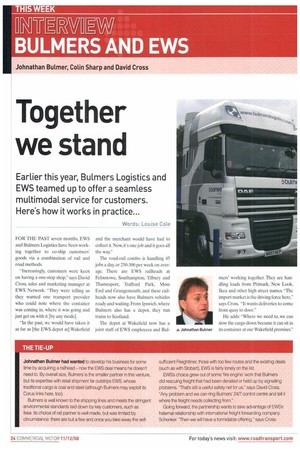Together we stand
Page 24

Page 25

If you've noticed an error in this article please click here to report it so we can fix it.
Earlier this year, Bulmers Logistics and EWS teamed up to offer a seamless multimodal service for customers. Here's how it works in practice...
Words: Louise Cs FOR THE PAST seven months, EWS and Bulmers Logistics have been working together to co-ship customers' goods via a combination of rail and road methods.
"Increasingly, customers were keen on having a one-stop shop," says David Cross, sales and marketing manager at EWS Network. "They were telling us they wanted one transport provider who could note where the container was coming in, where it was going and just get on with it [by any mode].
"In the past, we would have taken it as far as [the EWS depot at] Wakefield and the merchant would have had to collect it. Now, it's one job and it goes all the way."
The road-rail combo is handling 45 jobs a day, or 250-300 per week on average. There are EWS railheads at Felixstowe, Southampton, Tilbury and Tharnesport, Trafford Park, Moss End and Grangemouth. and these railheads now also have Bulmers vehicles ready and waiting. From Ipswich, where Bulmers also has a depot, they run trains to Scotland.
The depot at Wakefield now has a joint staff of EWS employees and Bul mers' working together. They are handling loads from Prirnark, New Look, Ikea and other high street names. "The import market is the driving force here," says Cross. "It wants deliveries to come from quay to door."
He adds: "Where we need to, we can slow the cargo down because it can sit in A Johnathan Butmer its container at our Wakefield premises"
"That's important for the customer, because a big cost for importers is the quayside charge. We get it off the quayside as fast as possible and that's really what's selling the product at the moment," explains Colin Sharp, accounts manager at EWS.
The companies are also shipping regular loads of apples and pears from Tilbury to Yorkshire.
"Fruit comes in to the distribution centres and the containers are sent back empty on the train," says Sharp. "It's a fast turnaround."
Reasons for collaboration
So, leaving aside the volume of work these companies have decided to share,what drove the two organisations together in the first place?
For EWS it was customer demand. Trains have trouble shipping to the door, and, as Cross says: "I didn't want to use Bulmers and others as subcon tractors. We wanted one partner with agreed standards, quality and an easier interface." Equally, investing in its own fleet, as Freightliner has done, seemed a futile exercise for EWS.
But what of Bulmers? Why is managing director Johna than Bulmer so keen to give away the majority of miles in every journey? "Until 18 months ago, I would have been in that frame of mind, always wanting the long haul," he says. "But you have to look at other factors, such as the Working Time Directive, tachographs, congestion, fuel, environmental issues. All these dictate a different view of how to use your trucks. We want to be doing three or four loads a day with our trucks.
As opposed to being stuck in traffic outside Southampton...
Cross reveals that EWS has a 'side door' to the container port, so it can get containers out of the port and on route fast: "If we are charging £450 to bring a container North and Buliners get £150 for the last leg, but can do three in a day then..."
"We've made as much money as we would have done with a fraction of the fuel and the mileage,Bulmer interjects. -Drivers want a more sociable life as well Gone are the days when they will drive all week with unpredictable hours."
Geographical goats
Buttner, based in Middlesbrough, has been growing his business in the South for some time. "Around 75% of freight into the southern ports is destined for north of Birmingham. It makes sense to evacuate this freight for local delivery in the north, It's growing our business."
The system has a single mileagebased tariff, which basically combines each companies' costs and required margin. Like road hauliers. EWS will typically earn a 3% margin if trains are 80% full. Twenty wagons are standard, but it runs 26 wagons whenever it can — the extra containers take it well into profit. Both companies expect the partnership to push volume and therefore maintain margins.
Bultner agrees: "The market is flat and yet we have shipped almost as much freight as we have capacity for. Others are trying to do this, but we are determined not to buy the business.
-This is a fresh venture and it was set up simply so we are not charging extra for a complex admin system.
"We want a sustainable business built on good service." •




























































































































































